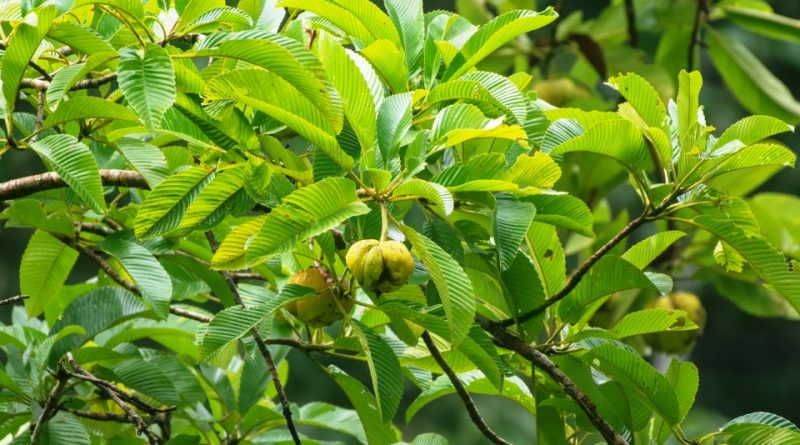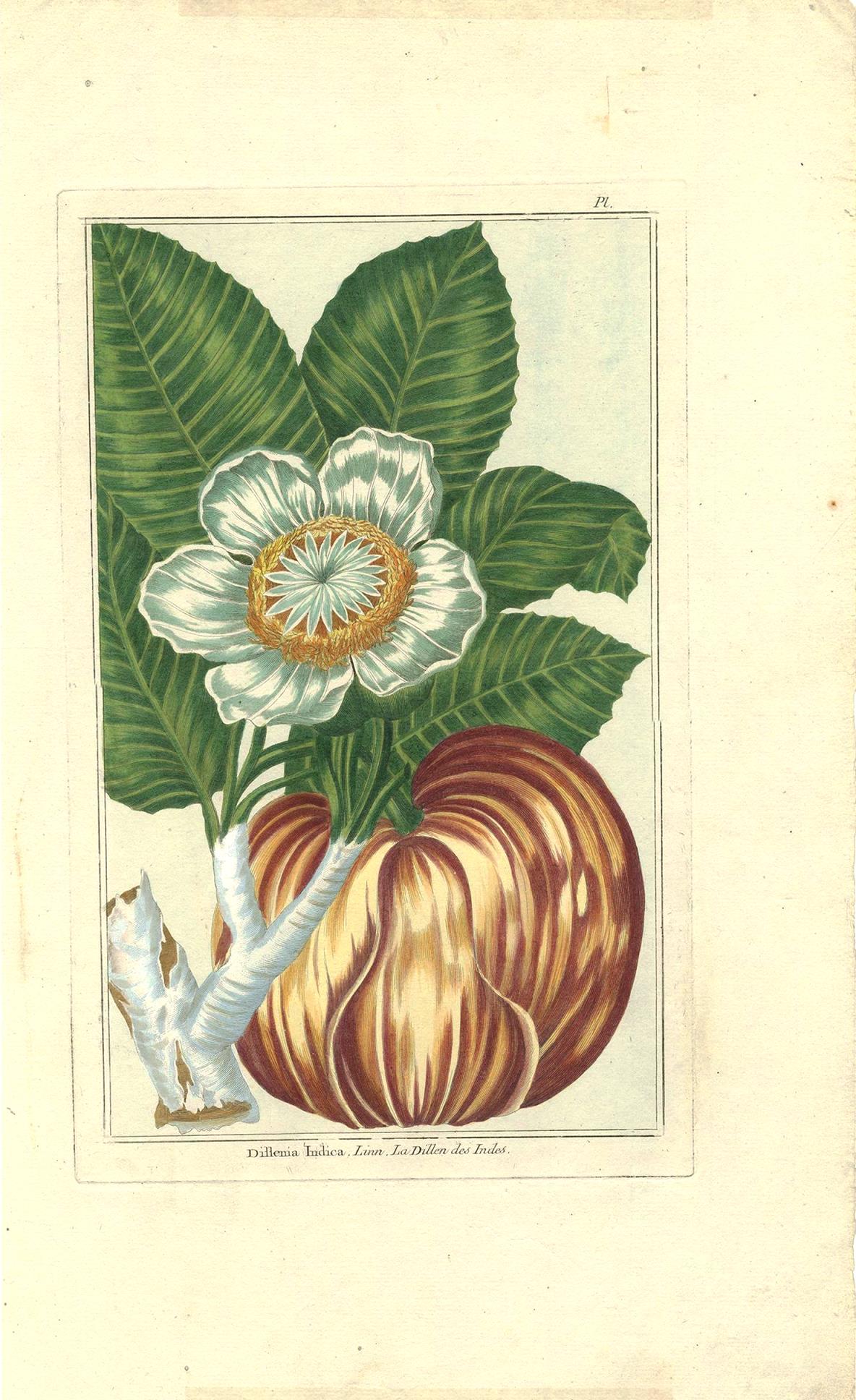Dillenia indica
Dillenia indica
The elephant apple or chulta, ou tenga (Dillenia indica L., 1753) is a shrub species belonging to the Dilleniaceae family.
Systematic –
From a systematic point of view it belongs to:
Eukaryota domain,
Kingdom Plantae,
Division Magnoliophyta,
Class Magnoliopsida,
Dilleniales Order,
Dilleniaceae family,
Genus Dillenia,
Species D. indica.
The terms are synonymous:
– Dillenia elliptica Thunb.;
– Dillenia elongata Miq.;
– Dillenia indica f. elongata (Miq.) Miq.;
– Dillenia speciosa Thunb..
Etymology –
The term Dillenia was dedicated in honor of the German botanist Johann Jacob Dillen (Latinized as Dillenius) (1687-1747).
The specific epithet indica comes from the Latin “indica”, that is, from India in reference to one of the places of origin.
Geographic Distribution and Habitat –
Dillenia indica is a plant native to an area that includes Yunnan (China), India, Indonesia, Malaysia, Sri Lanka, Thailand and Vietnam.
Its habitat is that of evergreen forest or tropical rainforest, often along rivers. In Java it is mainly present in teak forests, up to 1,100 meters above sea level.
Description –
Dillenia indica is a small to medium sized evergreen shrub or tree, with a rounded crown, growing to a height of 15 (25) m. The bark is smooth, reddish brown in color and flakes off; the young branches are tomentose. The trunk can reach 120 cm in diameter, often branching from below.
The leaves are intense green in colour, shiny on the top, alternate, usually grouped at the apex of the branches, elliptical-oblong or obovate-oblong in shape; they are 15-40 cm long and 7-14 cm wide with prominent parallel lateral veins and toothed margins; the petioles, 2-6 cm long, are grooved and pubescent at the base.
The flowers are solitary, terminal, hanging on a peduncle about 8 cm long, large, up to about 20 cm in diameter, with five rounded, concave, thick and fleshy sepals, 4-6 cm long, of a pale green colour. The corolla, made up of five white obovate petals, 7-10 cm long and 6-8 cm wide, surrounds numerous yellow stamens which form a compact mass on which the white lanceolate styles stand out, arranged radially, about 2.5 cm long.
Its fruits are large, round, greenish-yellow in color, with many seeds, and are edible. The fruit is an aggregate 5-12 cm in diameter composed of 15 carpels, each of which contains five seeds immersed in a fibrous and edible pulp.
Cultivation –
Dillenia indica is a very ornamental evergreen plant that provides an edible fruit, soap and medicines for the local population. It is often grown in gardens, where it is highly prized for its large, beautiful and fragrant flowers, as well as its edible fruits.
In India it is not cultivated commercially, but is found wild in the Duars and Terai region in the Katha, Burihiding, Duarmara, Tarani, Dumduma, Nalni, Philobari, Takowani, Kakojan, Digboi, Bogapani and Upper Forest reserves. . As it is one of the main foods for elephants, monkeys and deer, harvesting of the fruit is prohibited in the central areas of forest reserves. The sale of the fruit is also prohibited, to avoid the total dismantling of the jungle food chain.
It is a plant that can be cultivated in tropical and humid subtropical climate zones, with minimum temperatures that should not fall below +10 °C, even if it can survive, for a short period, at temperatures around -2 °C and where it is found up to 1,100 meters above sea level.
It grows best in areas where annual daytime temperatures are between 30 and 40°C, but can tolerate 7-47°C.
It prefers an average annual rainfall of between 3,000 and 4,000 mm, but tolerates 2,000 – 5,500 mm.
From a pedological point of view it prefers sandy, neutral or acidic soils, kept humid, if kept dry in winter it can lose its leaves. In general well-drained soils and sunny positions and grows best in rich soil with a pH between 5.5 and 7, tolerant up to 8.
It prefers a sunny position, but the plants tolerate shade very well: vigorous saplings have been found in dense shade.
The plant reproduces by seed and it seems that the dispersal of the seeds is carried out by animals, among others by elephants, or by running water. In the latter case the seeds can germinate in the fruit, which is left on the bank of a river, often partly filled with mud which gives a substrate favorable to germination.
It can also be propagated through cuttings of semi-mature wood.
Customs and Traditions –
Dillenia indica is a plant that was one of many first described by Linnaeus in the tenth edition of his Systema Naturae in 1759.
It is known by various common names including: chulta, dillenia, elephant-apple, hondapare tree (English); chalta (Bengali); babau, graine bourrique, pomme d’éléphant (French); chilta, girnar, karambel, hondapara, outenga (Hindi); fruta-estrela, árvore-da-pataca, árvore-do-dinheiro, bolsa-de-pastor, dilênia, flor-de-abril, maçã-de-elephant (Portuguese); manzano de los elephants (Spanish); chalthafrucht, elephantenapfel, indischer rosenapfel (German); owtenga (ঔটেঙা) (Assamese); chalta (চালতা) (Bengali); ouu (ଓଉ) (oriya).
The pulp of the fruit is bitter-sour and is used in Indian cuisine in curries, jam (ouu khatta) and jellies. It is often mixed with coconut and spices to make chutney. In Assam it is widely used in the preparation of dal and fish.
The name elephant apple comes from the fact that it produces a large, hard, edible fruit that is only accessible to megaherbivores in the wild such as elephants. A study conducted by ecologists Sekar and Sukumar in the Buxa Tiger Reserve showed that Asian elephants appear to have a particular predilection for the fruits of D. indica and are therefore an important seed disperser for this tree. With the prospect of elephant extinction, this tree has developed a reserve system, whereby its hard fruits, accessible only to megaherbivores, slowly soften on the forest floor during the dry season to allow access by animals subsequently smaller ones such as macaques, rodents and squirrels. The seeds of both old and tender fruits are able to germinate well, allowing the persistence of this tree to be independent of the survival of its primary megaherbivore disperser.
Laboratory studies have also highlighted an antileukemic activity of fruit extracts, probably due to the presence of betulinic acid.
The wood is compact and durable and has moderate use in construction and for making crates, plywood and other objects.
The wood, moderately hard and with an underwater durability of about 3 years, is sometimes used for construction or for rifle stocks.
Its branches are used to produce good quality firewood.
Among other uses, remember that the fruits can be rubbed in water to make soap. The pulp is used as a hair cleanser.
The juice of the leaves is applied to the scalp to prevent baldness.
The dried leaves are used to polish ivory.
Wood ash is added to clay bricks to increase their fire resistance.
Preparation Method –
Dillenia indica is a plant that grows both spontaneously and cultivated for various uses.
The pulp of its fruits is acidic and is used in Indian cuisine in curries, jam (ouu khatta) and jellies, in drinks or fermented into vinegar.
The fleshy sepals, with a pleasant sour flavour, are eaten raw or cooked, or used to prepare jams and jellies and to flavor curry; the fruits are also consumed, albeit to a lesser extent and mostly cooked, having a decidedly acidic flavour, they are slightly laxative so it is prudent not to abuse them.
The leaves, bark and fruits are used in traditional medicine mainly as anti-inflammatories; the juice of the fruit is used to prepare cough syrups and mixed with water and sugar to reduce fever, the bark for poultices in arthritis.
The fruits have a taste and flavor similar to unripe apple. The majority of the fruit is in fact made up of very thick sepals, which have a very sour flavour. Even the smallest, juiciest fruits inside are sour.
In the medicinal field the fruit is tonic and laxative; it is used in the treatment of abdominal disorders and is mixed with sugar to be used against coughs.
The bark and leaves are astringent.
The bark is used as a mouthwash to treat thrush.
Guido Bissanti
Sources
– Acta Plantarum – Flora of the Italian Regions.
– Wikipedia, the free encyclopedia.
– GBIF, the Global Biodiversity Information Facility.
– Useful Tropical Plants Database.
– Conti F., Abbate G., Alessandrini A., Blasi C. (ed.), 2005. An annotated checklist of the Italian vascular flora, Palombi Editore.
– Pignatti S., 1982. Flora d’Italia, Edagricole, Bologna.
– Treben M., 2000. Health from the Lord’s Pharmacy, Advice and experiences with medicinal herbs, Ennsthaler Editore.
Photo source:
– https://inaturalist-open-data.s3.amazonaws.com/photos/236902447/original.jpg
Attention: Pharmaceutical applications and food uses are indicated for informational purposes only, they do not represent in any way a medical prescription; we therefore decline any responsibility for their use for healing, aesthetic or food purposes.


